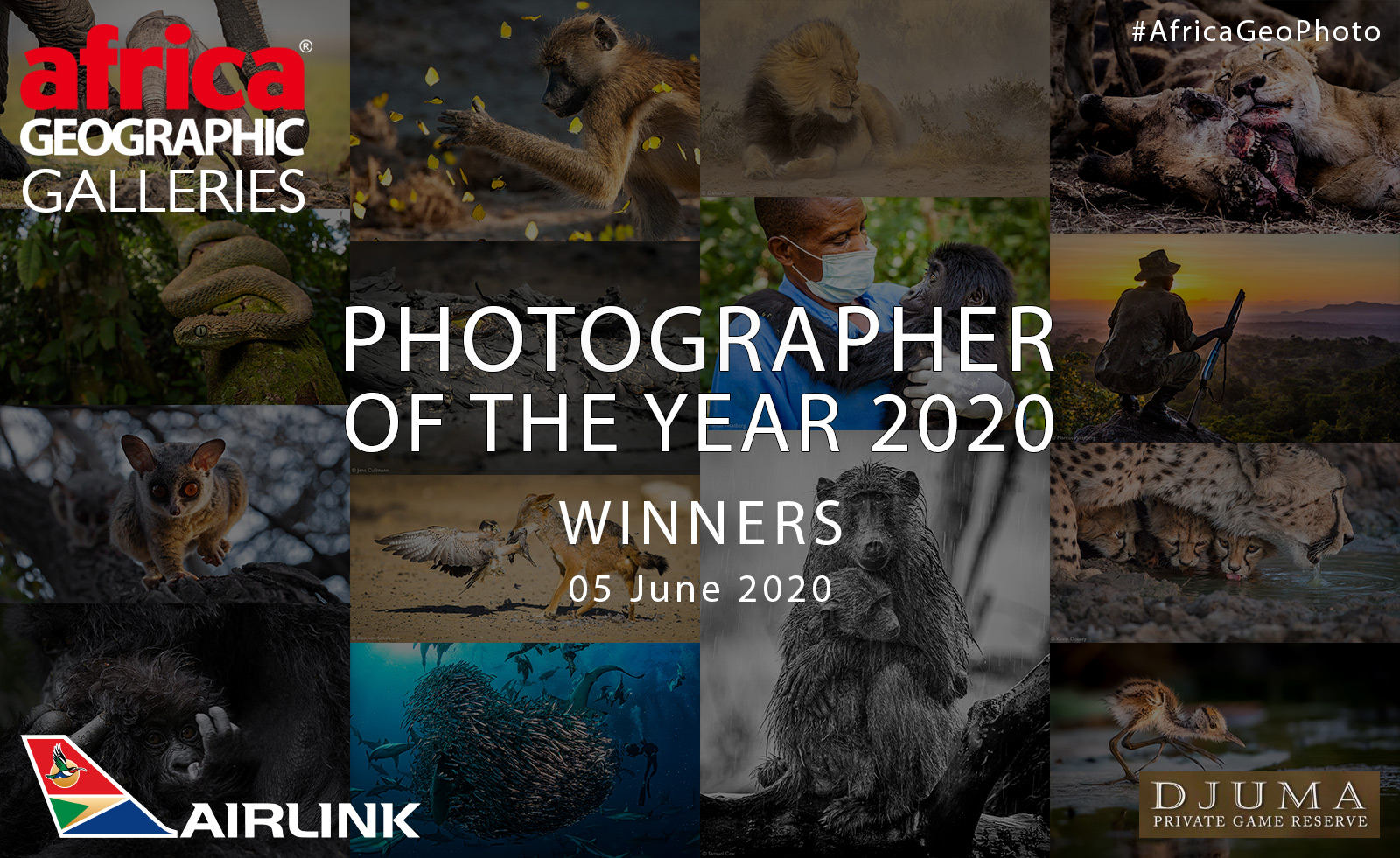
Photographer of the Year 2020 WINNERS


Our Photographer of the Year 2020, with a stunning safari prize provided by Djuma Private Game Reserve has drawn to a close and, after a month of judging, we have whittled down 37,853 entries to a winner, two runners-up and 12 highly commended images.
MESSAGE FROM OUR CEO:
What a privilege it has been for us to judge some of the best images ever taken of this achingly beautiful continent we call home.
And this year was super-tough – with so many outstanding images that deserve to go further than they did. On top of that, we again broke all previous records, with 37,853 submissions – a whopping 27% increase over last year!
Our judging is based on whether the image evokes an emotion, tells a story and reflects the true diversity and amazingness of Africa. Of course, there are technical issues to consider, and these are important. But most important for us is that the photograph breaks through the clutter of everyday life and makes you FEEL Africa’s pulse.
I would like to thank our sponsors, who support wholeheartedly our ongoing pursuit of individuality and authenticity.
Above all, our thanks to everybody who submitted photographs for consideration. Without your impressions of life in the far-flung corners of this great continent, we would all be the poorer. Please do so again in 2021 (submissions open on 1 December 2020).

Simon Espley, Africa Geographic CEO
WINNER – PHOTOGRAPHER OF THE YEAR 2020
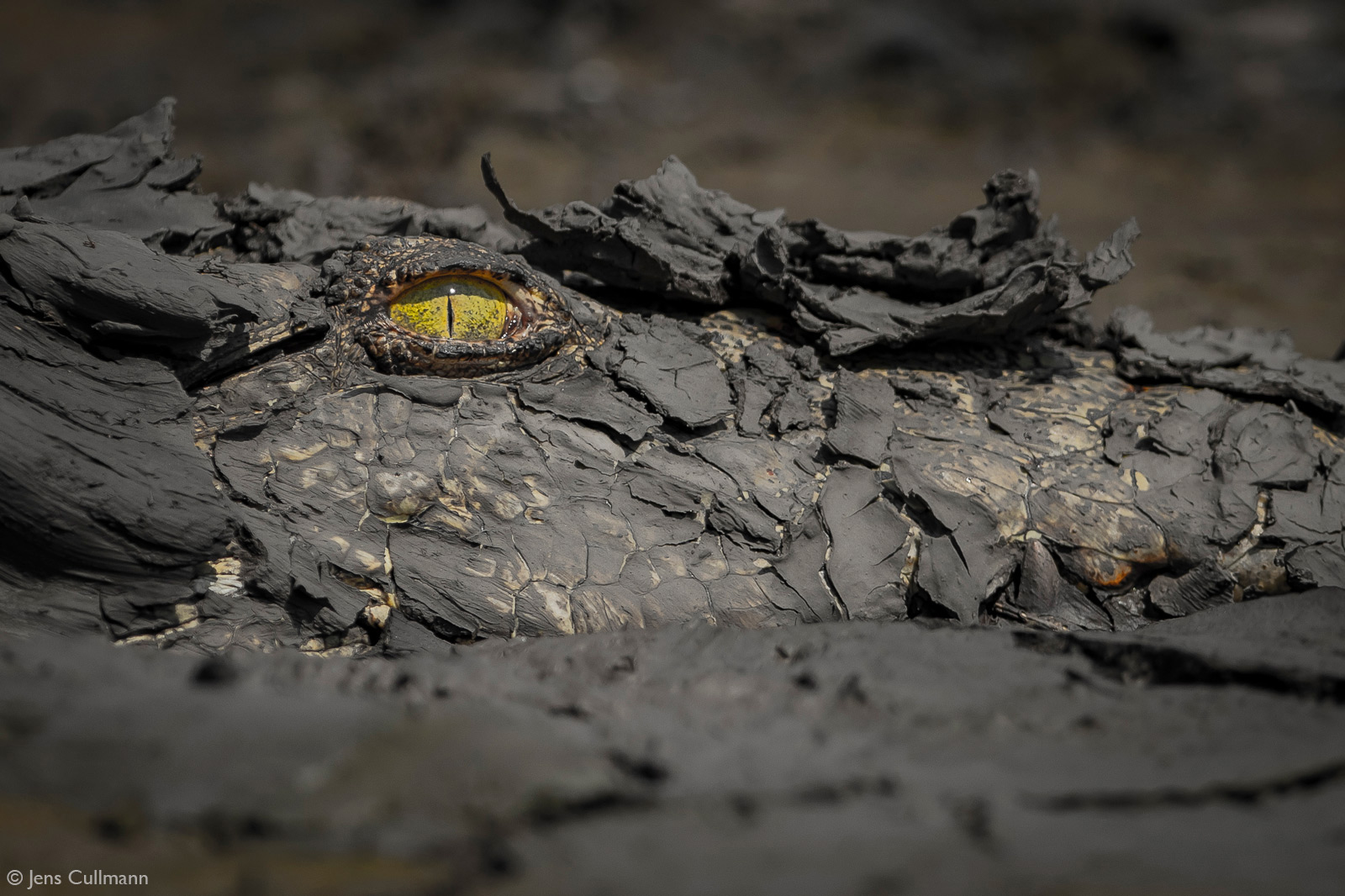
This photograph resulted from my staking out the largest pool at Mana Pools National Park, Zimbabwe – at a time when an extended drought had reduced the pool to rapidly-drying mud. I had to be very careful not to disturb this crocodile, even though it was buried in dry mud. They will launch themselves with tremendous speed and power at any animal foolish enough to come too close.
During the dry season, temperatures can reach 45 degrees Celsius and crocodiles will attempt to reduce their body temperature by burying themselves in mud. A giant crocodile such as this one could survive submerged for months without eating by living off its fat reserves – a process known as aestivation.
Judges’ comment
Aside from the evident technical prowess of this image, the story it tells goes to the core of the essence of life in the wild. The moment was captured at the peak of an acute drought period which brought about an agonising death for many thirsty, starving animals. These periods of intense hardship are when nature is testing limits and ensuring survival for those that adapt and evolve. This is wild Africa’s story: one of resilience and patience to ride out the seasonal cycles and periodic imbalances.
About the photographer
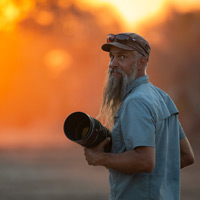 Jens Cullmann was born in Nuremberg, Germany, in 1969. His introduction to photography was at age 13 when he got his first camera. As a teenager, he worked with black & white film and image developing until he was able to acquire more sophisticated equipment. ‘There is a very physical aspect to my work because you need a lot of discipline and endurance to deal with some of the tough environments that come with wildlife photography.’ It was during a trip to Namibia and Botswana in 2003 that Jens’ passion for wildlife photography really ignited and he has grown in stature since then. He has won several prestigious international awards such as the 2017 Botswana Wildlife Photographer of the Year, 2018 International Photographer of the Year and most recently, he was the winner of the 2020 GDT Nature Photography of the Year 2020 (German Society for Nature Photography). Jens was a runner-up in the 2019 Africa Geographic Photographer of the Year.
Jens Cullmann was born in Nuremberg, Germany, in 1969. His introduction to photography was at age 13 when he got his first camera. As a teenager, he worked with black & white film and image developing until he was able to acquire more sophisticated equipment. ‘There is a very physical aspect to my work because you need a lot of discipline and endurance to deal with some of the tough environments that come with wildlife photography.’ It was during a trip to Namibia and Botswana in 2003 that Jens’ passion for wildlife photography really ignited and he has grown in stature since then. He has won several prestigious international awards such as the 2017 Botswana Wildlife Photographer of the Year, 2018 International Photographer of the Year and most recently, he was the winner of the 2020 GDT Nature Photography of the Year 2020 (German Society for Nature Photography). Jens was a runner-up in the 2019 Africa Geographic Photographer of the Year.
“I have come to realise that my images evoke intense discussions about Africa’s wild places and about how nature functions, and so stimulating these important debates has become part of my personal narrative. I hope to use this opportunity to create awareness about conservation issues and the preservation of natural habitats. Every time I am out in nature, I appreciate the rawness of its beauty, the working balance of all its elements, and how urgently we have to preserve it. Visit my website and Instagram page.”
RUNNERS-UP
(in no specific order)
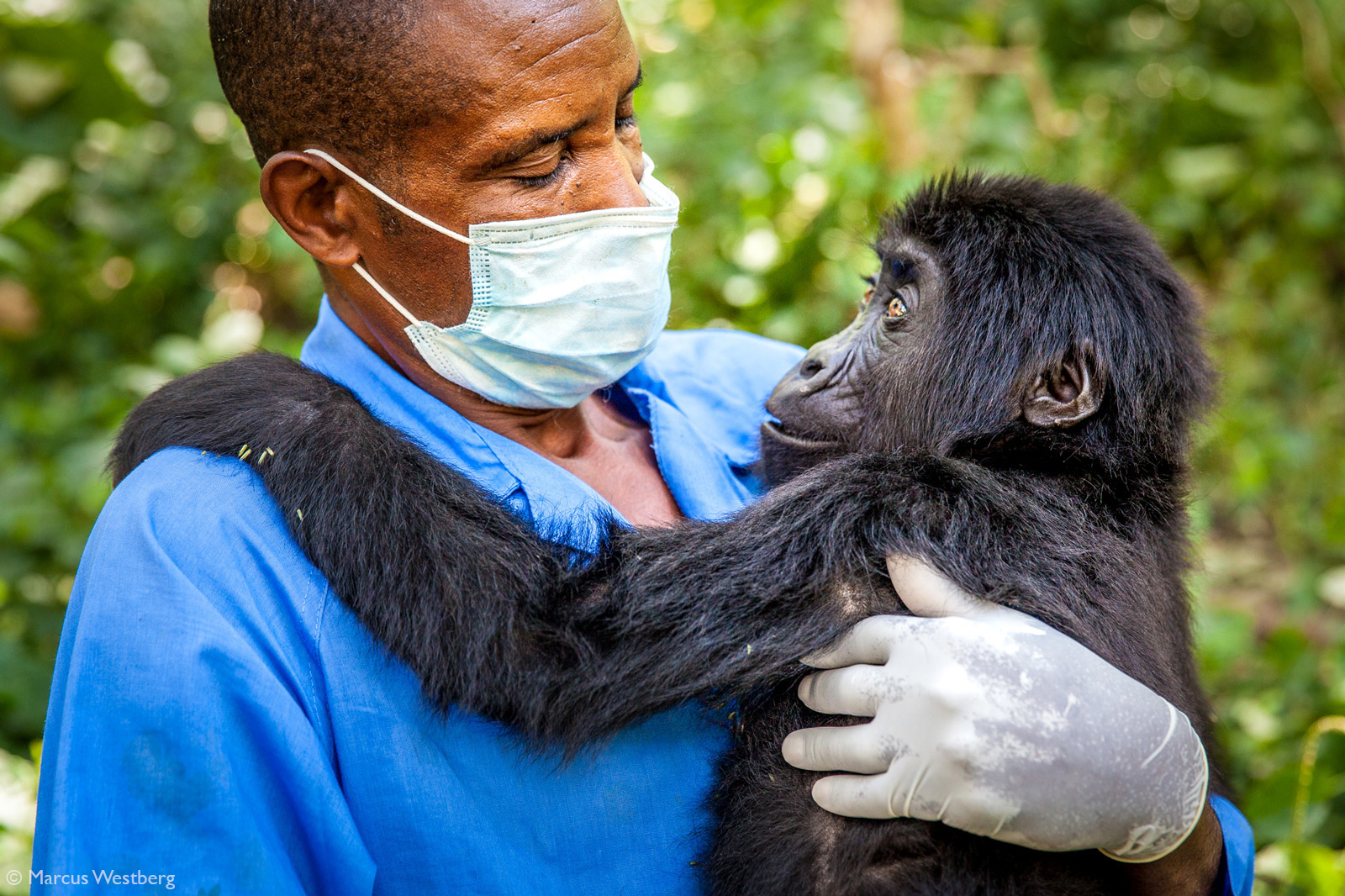
Kalonge, an orphaned Grauer’s gorilla, is held by caregiver Philippe Bitege at Senkwekwe Gorilla Orphanage in Virunga National Park, DR Congo. She had just undergone a health examination by Gorilla Doctors veterinarian Eddy Kambale and would soon be moved to a different sanctuary. This new sanctuary, ‘Grace’, is dedicated to Grauer’s rather than mountain gorillas. Although her stay at Senkwekwe was brief, and her past traumatic, she quickly bonded with Philippe, reflecting the deep trust that many rescued gorillas feel for their human carers.
Judges’ comment
Photography is about storytelling. This exceptional image tells TODAY’S story of dangerous viruses and humankind’s impact on the natural world like no other. Need we say more?
About the photographer
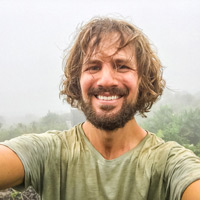 Marcus Westberg is an award-winning Swedish photographer and writer who focuses primarily on solution-oriented coverage of conservation topics in sub-Saharan Africa. He is a photographer for African Parks, and his work is frequently found in publications such as the New York Times, bioGraphic, Vagabond, Wanderlust and Africa Geographic. Visit his Instagram page.
Marcus Westberg is an award-winning Swedish photographer and writer who focuses primarily on solution-oriented coverage of conservation topics in sub-Saharan Africa. He is a photographer for African Parks, and his work is frequently found in publications such as the New York Times, bioGraphic, Vagabond, Wanderlust and Africa Geographic. Visit his Instagram page.

While on safari in Kruger National Park, South Africa, we came across a pride of lions that had just made a giraffe kill on the edge of a game track. We returned to this site on several occasions over the next four days. On this particular day, I noticed that a lioness had fallen asleep with her head on the head of the dead giraffe. She was exhausted from four days of feeding.
Judges’ comment
That macabre toothy grin juxtaposed with a content lion using her food as a pillow is what Africa is all about. Nature still rules in our wild spaces, in defiance of human feelings, prejudices and packaging! Forget Disneyfication, this outstanding image tells a true story – that life in the wild is all about eating or being eaten.
About the photographer
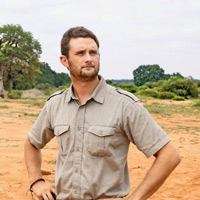 Julien Regamey’s interest and passion for the natural world began at a young age when he commenced his studies at Vivarium de Lausanne, Switzerland, under renowned herpetologist Jean Garzoni. After three years Julien went on to complete his education at Kinyonga Reptile Centre in the town of Hoedspruit near the Kruger National Park, South Africa. He then trained at the nearby Siyafunda Wildlife and Conservation, which equipped him with the skills to identify local fauna and flora, track wildlife and gain essential bush survival skills.
Julien Regamey’s interest and passion for the natural world began at a young age when he commenced his studies at Vivarium de Lausanne, Switzerland, under renowned herpetologist Jean Garzoni. After three years Julien went on to complete his education at Kinyonga Reptile Centre in the town of Hoedspruit near the Kruger National Park, South Africa. He then trained at the nearby Siyafunda Wildlife and Conservation, which equipped him with the skills to identify local fauna and flora, track wildlife and gain essential bush survival skills.
It was during his training that he became interested in photography, and specifically wildlife photography. His eight years of guiding experience and knowledge of African wildlife continues to enrich and inspire him to become a successful wildlife photographer. Visit his Instagram page.
HIGHLY COMMENDED
(in no specific order)

Another fantastic (and privileged) day on the trail of Rwanda’s mountain gorillas secured this image for me. We were on the Visoke (Bisoke) mountain tracking the Umubano silverback and his family group. Umubano means “living together” or “neighbours “. This small group is made up of eleven individuals and two silverbacks. Two of the females had young, and this image is a portrait of the youngest – at approximately two months old.
Judges’ comment
That direct eye contact between two sentient great apes makes this an engaging image, and the youngster’s snuggle in mom’s warm embrace completes an outstanding capture.
About the photographer
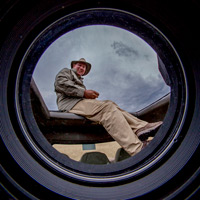 Andy Howe is a UK-based wildlife photographer who specialises in capturing the personality and character of his subjects, with a particular focus on owls and birds of prey. Andy leads small groups of photographers to India, Rwanda and Kenya. His images have been published in such publications and competitions as Bird Guides, Bird Photographer of the Year, Nature Photographer of the Year, Africa Geographic and Natures Best Awards. More recently he was appointed as a Fellow of the Society of International Nature and Wildlife Photographers and an Associate of the Royal Photographic Society.
Andy Howe is a UK-based wildlife photographer who specialises in capturing the personality and character of his subjects, with a particular focus on owls and birds of prey. Andy leads small groups of photographers to India, Rwanda and Kenya. His images have been published in such publications and competitions as Bird Guides, Bird Photographer of the Year, Nature Photographer of the Year, Africa Geographic and Natures Best Awards. More recently he was appointed as a Fellow of the Society of International Nature and Wildlife Photographers and an Associate of the Royal Photographic Society.
Andy donates images to worthy causes and is currently involved in a charity to raise funds for vulnerable and disadvantaged children. One of Andy’s images is to be published in the ‘Remembering Cheetahs’ book in aid of wildlife conservation for critically endangered species. Visit his Instagram page.
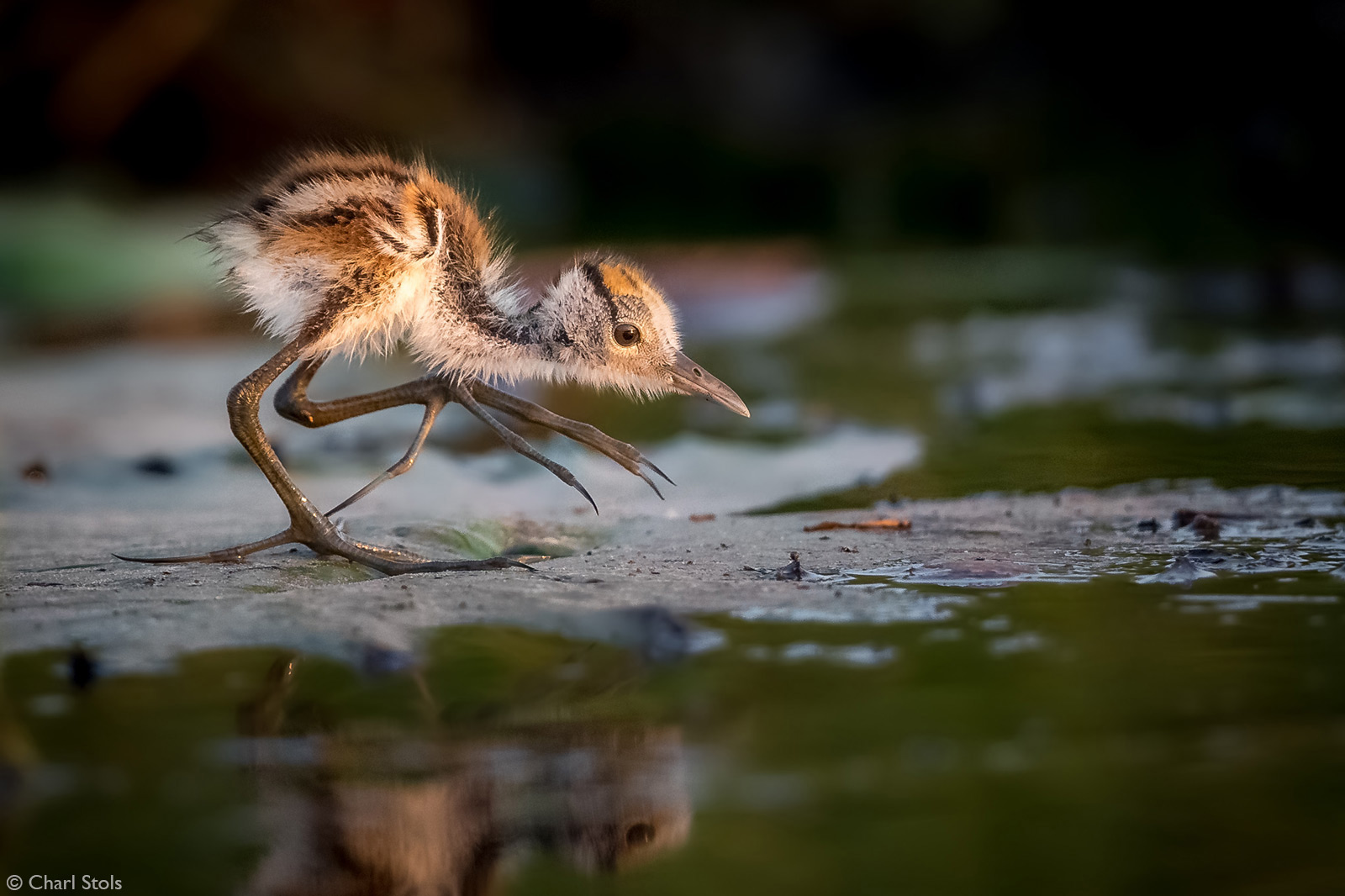
In Botswana’s summer (rainy) season water lilies start to grow on the surface of the Chobe River. Wading birds like the African Jacana use these lily pads as nesting and feeding grounds. In this image, an African Jacana chick is using its large feet to balance on the vegetation in search of food. Jacana chicks are usually found on the Chobe River during March to May.
Judges’ comment
What dangers lurk below for this delicate little fluffball as it treads cautiously across the lily pads? That juxtaposition of cuteness and vulnerability makes this an excellent image.
About the photographer
 Charl Stols was born and raised in South Africa, where he was fortunate to visit several national parks. He began his journey in photography in 2003 while working on a cruise vessel as a resident photographer in 2003. During that time, he also met his wife, Sabine, who shares his passion for photography.
Charl Stols was born and raised in South Africa, where he was fortunate to visit several national parks. He began his journey in photography in 2003 while working on a cruise vessel as a resident photographer in 2003. During that time, he also met his wife, Sabine, who shares his passion for photography.
Charl and Sabine were offered their dream jobs – as photographic hosts with a photo safari company – where they now work full-time. They guide clients on the Chobe River and other iconic photo destinations such as the Okavango Delta, Kalahari and Maasai Mara. Visit his Instagram page.
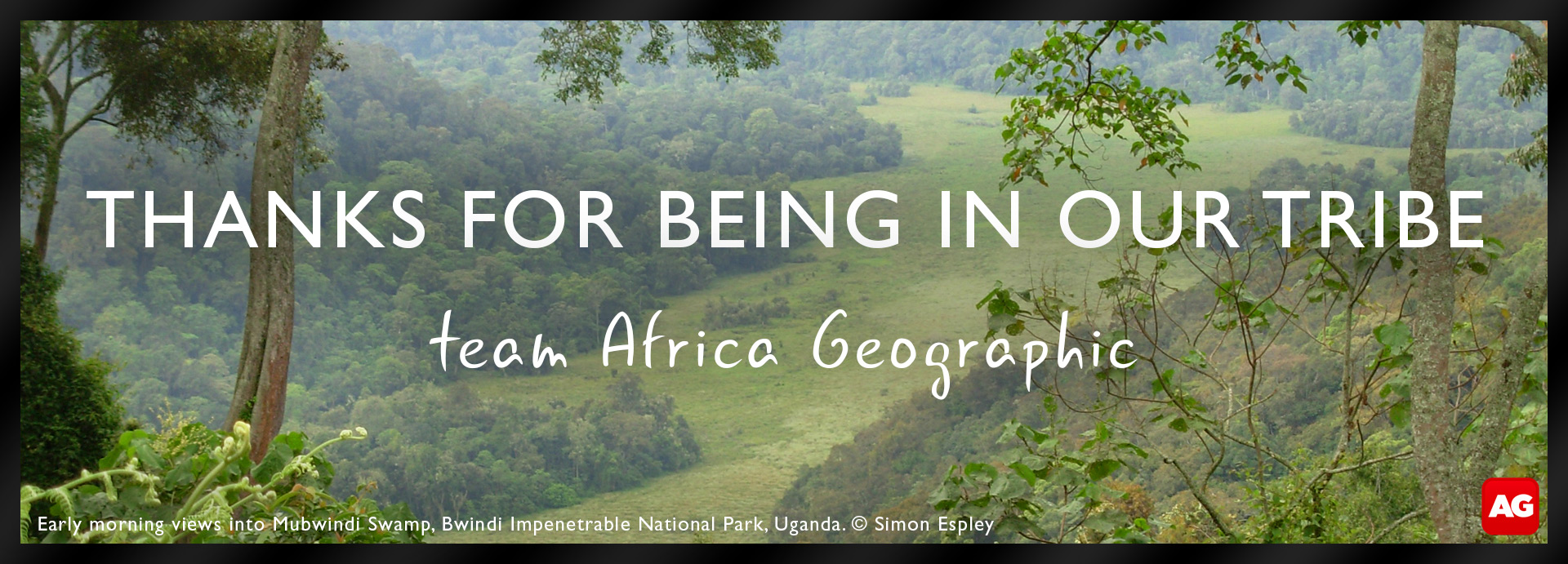
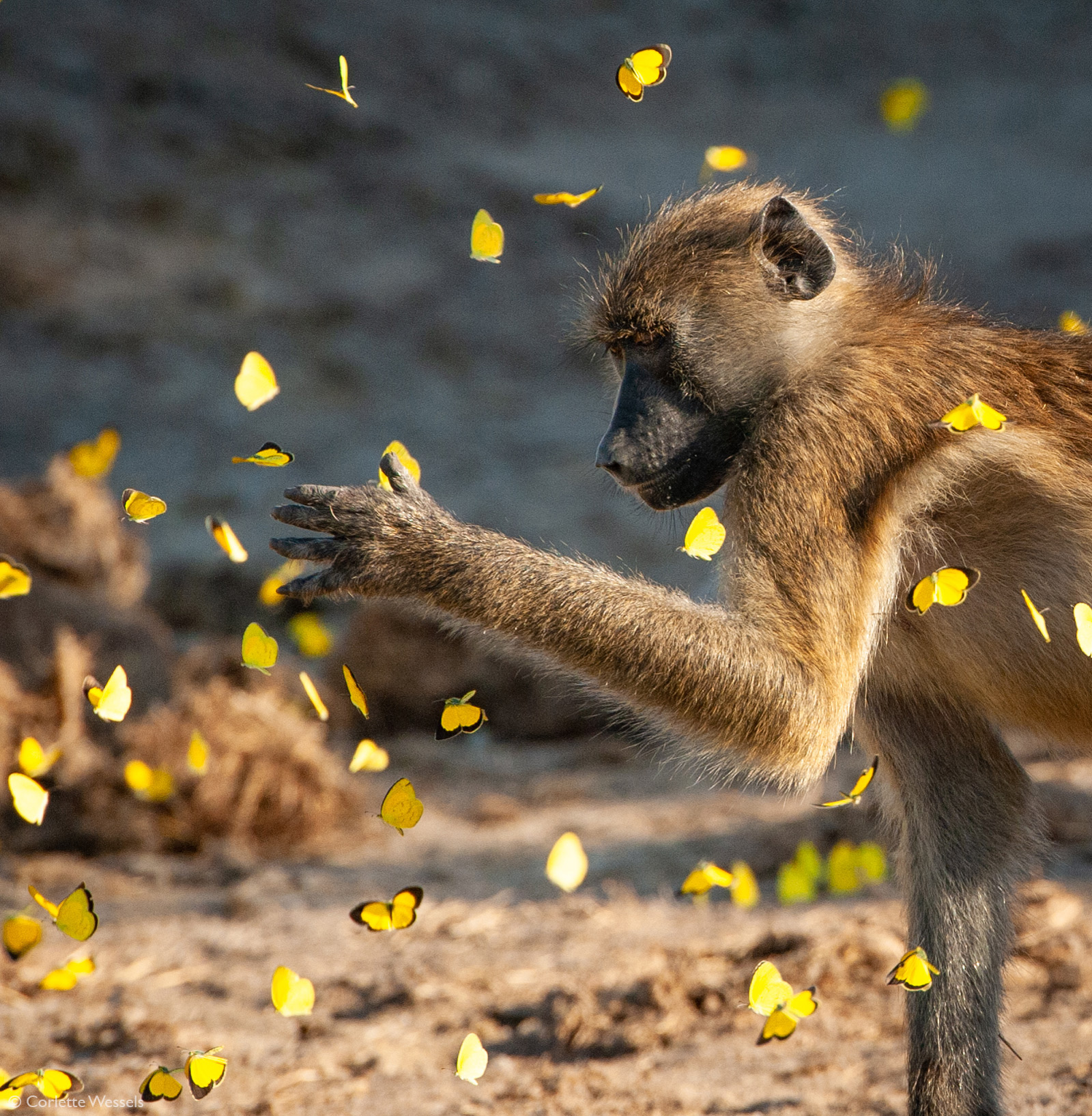
We were exploring the Chobe River in Botswana when we found a cloud of yellow butterflies in a bay that is usually popular with elephants. While we were watching the butterflies, a troop of baboons arrived to drink, and some of the youngsters kept us entertained by chasing each other, climbing and jumping down from the embankment.
I kept my eye on this young baboon as he walked around on his own after being chased by the other youngsters. He walked into the middle of the butterflies, sat down, and looked around him. What struck a chord with me was how he admired the butterflies, now and then reaching out his hand to gently touch them. He never tried to catch them – rather, he seemed hypnotised by these yellow butterflies as he gently waved his hand amongst them. Mother nature shared a special moment with me on that day.
Judges’ comment
There is a sense of innocence, a pursuit of simple pleasures in this image that transports us back to our childhoods – grasping at floating soap bubbles. A wonderful escape from the rigours and stresses of the current times.
About the photographer
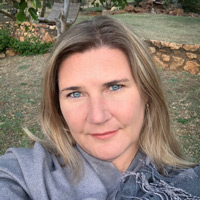 For Corlette Wessels photography is not merely a hobby; it’s her passion! Her father was an avid photographer and, as a child, she would always admire him behind his lens. Her love for photography grew as she got older, and she started with film and later turned to digital. By starting with film, she learned a great deal about photography, and of course learned her lessons the hard, expensive way. As her passion grew, she invested in better gear and several dedicated photographic trips with professional photographers. It was on those trips that she learned the most, from hands-on training.
For Corlette Wessels photography is not merely a hobby; it’s her passion! Her father was an avid photographer and, as a child, she would always admire him behind his lens. Her love for photography grew as she got older, and she started with film and later turned to digital. By starting with film, she learned a great deal about photography, and of course learned her lessons the hard, expensive way. As her passion grew, she invested in better gear and several dedicated photographic trips with professional photographers. It was on those trips that she learned the most, from hands-on training.
She usually uses aperture mode but will sometimes use manual mode with a favourite setting as her starting point. Her preference is to capture those special moments that elicit an emotional response from images.
She is very patient while waiting for that photographic opportunity and relies on a mix of instinct and her extensive experience of nature.
Photography is her soul food; looking over her images transports her back in time to that moment when she can smell the air, hear the sounds, and relive the emotions. Visit her Instagram page.
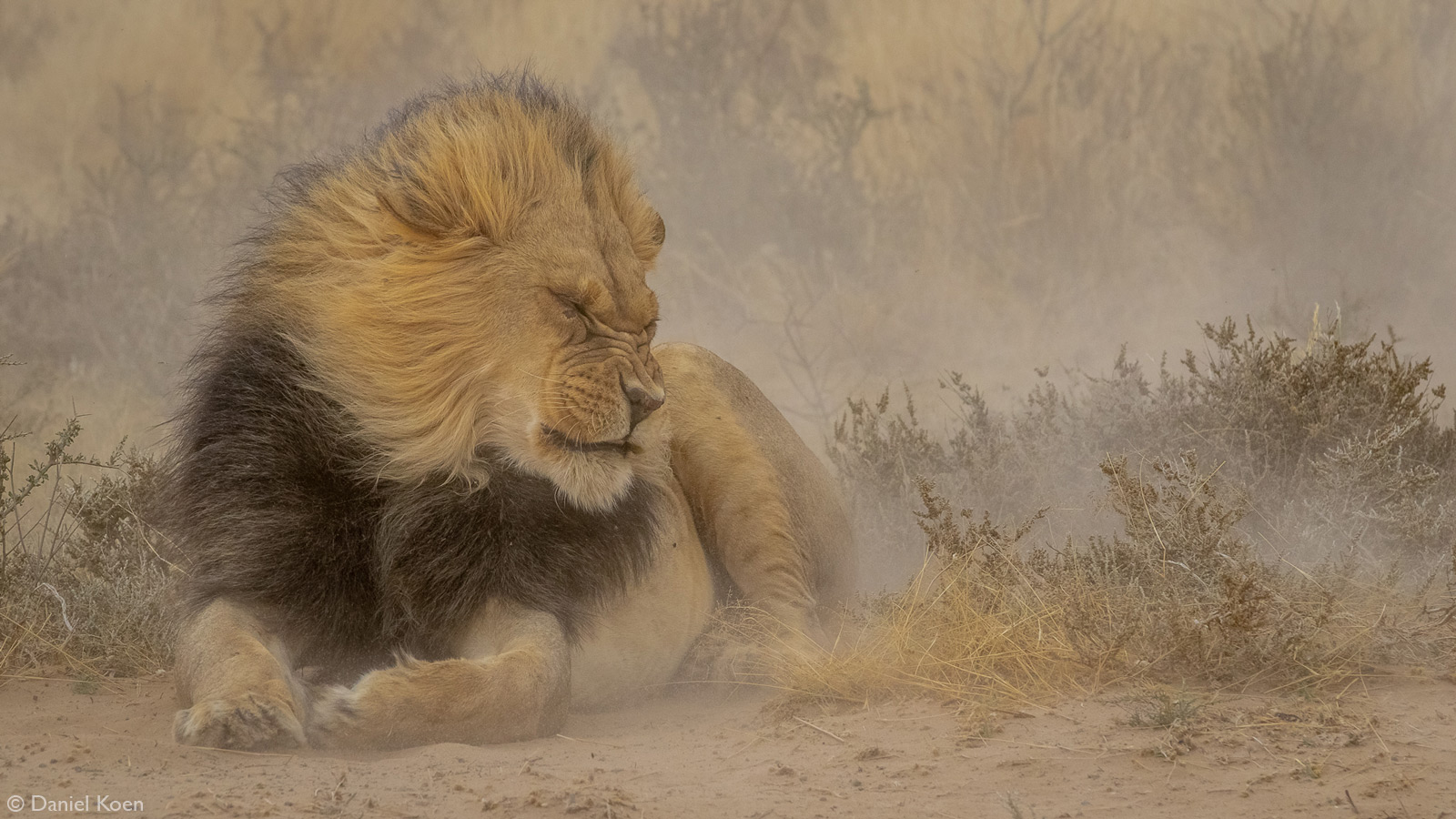
While in the Kgalagadi Transfrontier Park, we came across a pair of beautiful black-maned male lions lying up near a waterhole. There was a thunderstorm brewing in the distance, and a sandstorm closing in on us. There was no cover, and the lions had to endure the dust storm. The male lion in the photograph was not at all amused, and every time the dust swirled around him, he would grimace with displeasure. I cropped the photograph tightly to show the dissatisfaction on the lion’s face. The swirling sand made the photograph look like a painting. Camera settings: 1/640 sec, f 8, ISO 800.
Judges’ comment
Even the king hates having sand blown into his face! That grimace and blow-dried hairstyle had us all giggling as we felt his irritation. A refreshingly different portrayal to the usual machismo belligerence of a large male lion.
About the photographer
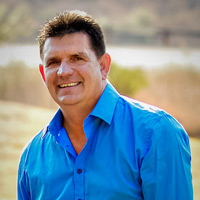 Daniel Koen was born in Durban, KwaZulu Natal, South Africa after which he moved to Alberton where he spent most of his life. His interest in nature and wildlife photography started at an early age during family trips to the Kruger National Park. He went on to study Nature Conservation at the then Pretoria Technikon and obtained a National Diploma in Nature Conservation. He currently works as a nature conservator in Gauteng. He has a deep love for the bush and dedicates as much time as possible to being in nature and honing his photographic skills. Visit his Instagram page.
Daniel Koen was born in Durban, KwaZulu Natal, South Africa after which he moved to Alberton where he spent most of his life. His interest in nature and wildlife photography started at an early age during family trips to the Kruger National Park. He went on to study Nature Conservation at the then Pretoria Technikon and obtained a National Diploma in Nature Conservation. He currently works as a nature conservator in Gauteng. He has a deep love for the bush and dedicates as much time as possible to being in nature and honing his photographic skills. Visit his Instagram page.

The venomous snakes of Uganda topped my list of photographic goals during a recent visit there. That country has some of the most incredible snake species, and this variable bush viper is undoubtedly amongst my favourites. One of my goals has been to showcase animals in their natural habitat so that viewers can get a sense of the ecosystem that they inhabit. This photo is important because it shows the snake in its rainforest habitat even though in this case the forest was a small patch amongst a predominantly agricultural landscape. Without intervention, this snake’s home may disappear forever.
Judges’ comment
The strong eye contact is an obvious attraction for this striking image, as is the sinuous symmetry of that serpentine body against the mossy bark and forested backdrop.
About the photographer
 Daniel Wakefield is a husband, father, pastor, and amateur wildlife photographer. He became interested in wildlife, especially reptiles, at a young age. When my family and I moved to Florida five years ago, I started to explore the world of photography to help me capture and share my love of these scaly creatures. One of my goals with photography is to help people see the beauty of these often maligned and misunderstood creatures, to promote their conservation. Visit his Instagram page.
Daniel Wakefield is a husband, father, pastor, and amateur wildlife photographer. He became interested in wildlife, especially reptiles, at a young age. When my family and I moved to Florida five years ago, I started to explore the world of photography to help me capture and share my love of these scaly creatures. One of my goals with photography is to help people see the beauty of these often maligned and misunderstood creatures, to promote their conservation. Visit his Instagram page.

I have been monitoring a small family of resident lesser galagos (bushbabies) for the past two and a half years. They have become accustomed to my presence and will go about their natural activities quite undisturbed by my close proximity. They usually make their appearance at dusk, and the low lighting conditions makes it very difficult to get a decent shot, especially when shooting with an 11-year-old camera. On this particular occasion, they came out earlier, while the sun was still above the horizon, and the lighting provided a fantastic photo opportunity. I was shooting on burst mode, and the clicking sound caught the attention of one of them. She came hopping down the branch for a closer look, allowing me to capture several images.
Judges’ comment
Anybody that has tried to photograph these bundles of nervous energy in relatively poor light will understand what an excellent capture this is, and the direct advance towards the lens adds an element of intrigue.
About the photographer
 My passion for birding was the catalyst that prompted me into wildlife photography. For the past 24 years, I have pursued this passion with a specific focus on capturing images of wildlife in their natural environments. My travels have taken me to some of the most extraordinary places that Africa has to offer. Amongst my most memorable trips are trekking with mountain gorillas in the Virunga mountains of Rwanda; trekking with wild chimpanzees in the Mahale Mountains of Tanzania, camping on the shores of Lake Tanganyika, exploring the waterways of the Okavango Delta in Botswana, the vast Busanga Plains of Kafue in Zambia and Mana Pools in Zimbabwe. It would be difficult to choose a specific favourite, but the most profound experience was sitting amongst wild mountain gorillas in the Virungas.
My passion for birding was the catalyst that prompted me into wildlife photography. For the past 24 years, I have pursued this passion with a specific focus on capturing images of wildlife in their natural environments. My travels have taken me to some of the most extraordinary places that Africa has to offer. Amongst my most memorable trips are trekking with mountain gorillas in the Virunga mountains of Rwanda; trekking with wild chimpanzees in the Mahale Mountains of Tanzania, camping on the shores of Lake Tanganyika, exploring the waterways of the Okavango Delta in Botswana, the vast Busanga Plains of Kafue in Zambia and Mana Pools in Zimbabwe. It would be difficult to choose a specific favourite, but the most profound experience was sitting amongst wild mountain gorillas in the Virungas.
Today I am living my dream, on the Buffelsdrift Private Game & Nature Reserve just north of Pretoria. Although photography is not my profession, I get to enjoy it daily. The resident lesser galagos have provided me with many hours of entertainment and thousands of photo opportunities. It is fitting, therefore, that one of these images have got me so far in this competition. Visit his Facebook page.
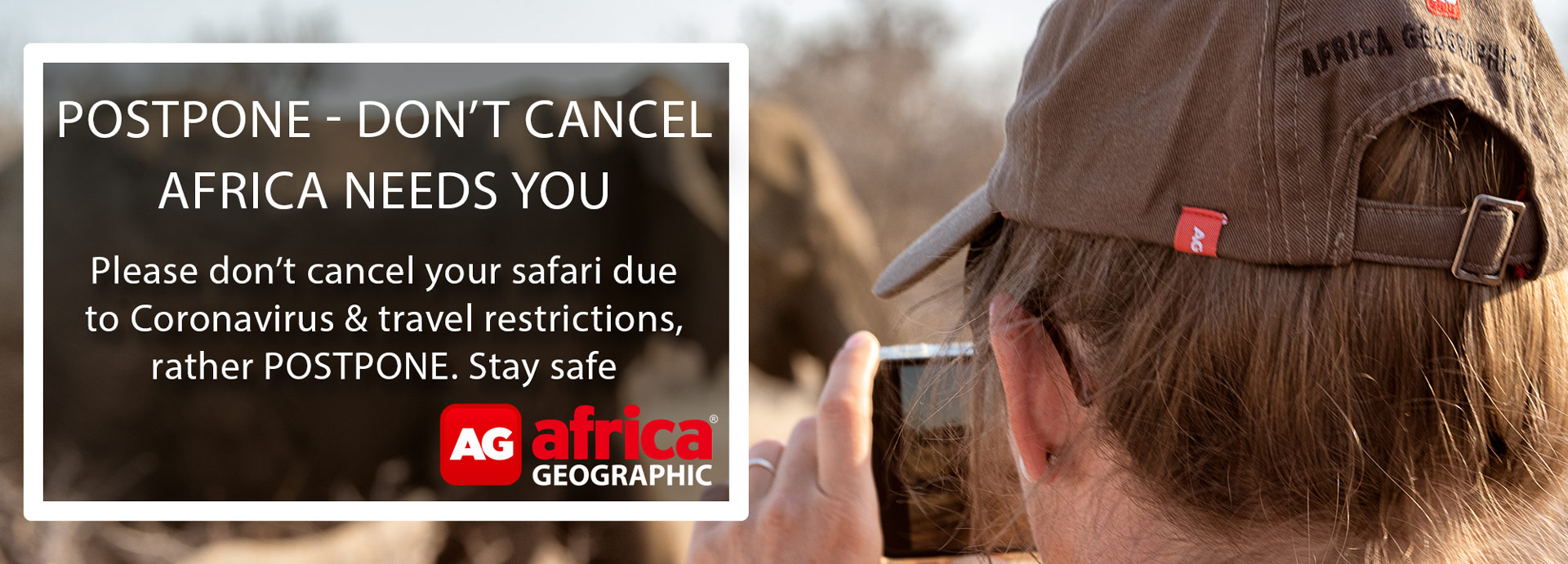
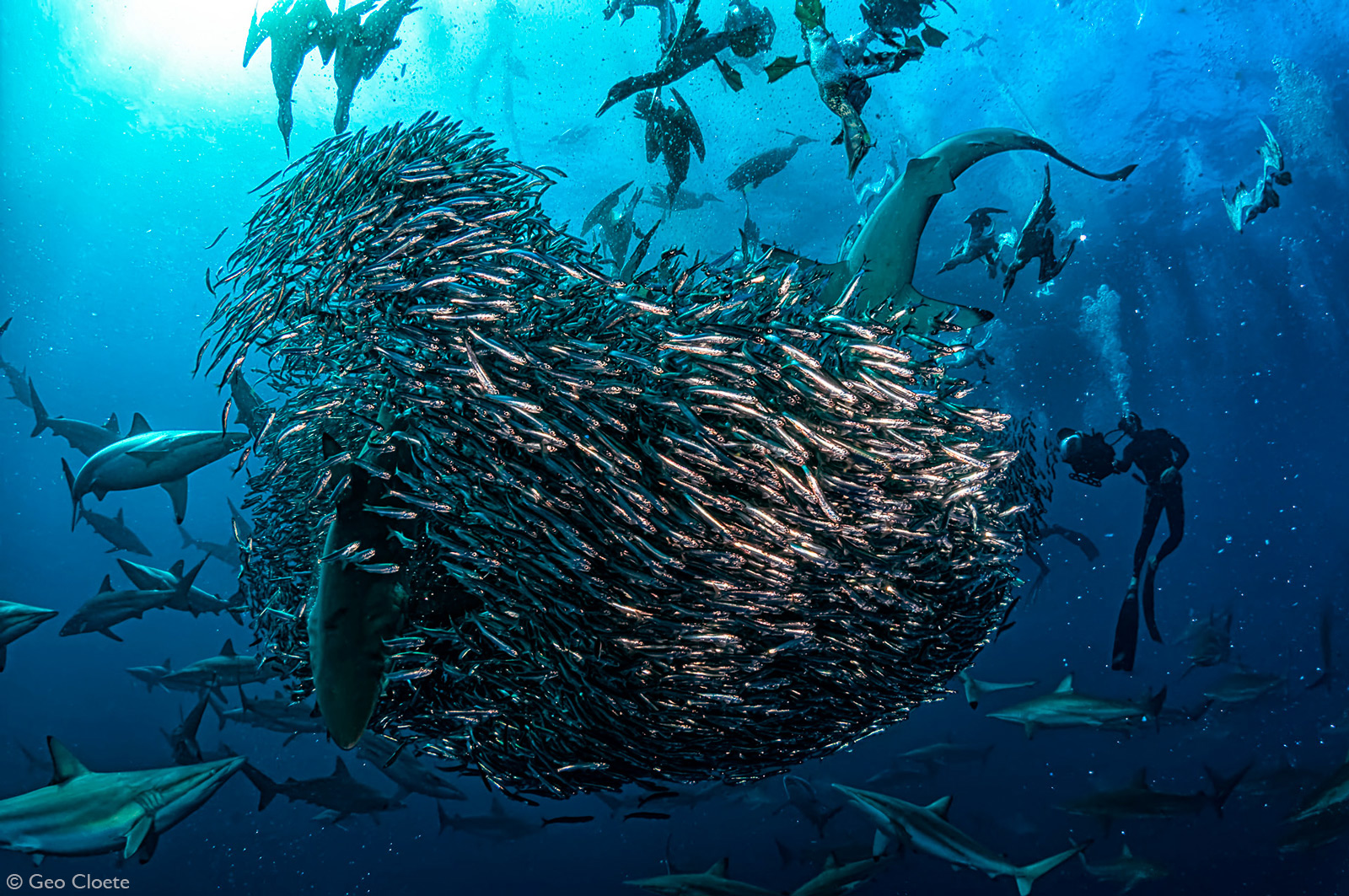
The sardine run has been described as the greatest wildlife spectacle on the planet. With most of the action taking place below the water, one can only imagine the magnitude of drama unfolding without any human eyewitnesses.
Before witnessing this bait ball, the belief was that only the fast-moving common dolphins were capable of keeping a bait ball from escaping. However, this bait ball was prevented from escaping by the sheer number of oceanic blacktip sharks present. Forming a virtual cage around the sardines, the sharks blocked all escape routes. Other predators such as skipjack tuna and Cape gannets joined the feeding frenzy, but it was the sharks which trapped the bait ball.
Judges’ comment
There is so much going on in this image as various sea and air predators work the bait ball and voyeuristic humans hover on the fringes. There is a palpable sense of frenetic action smothered in a cocoon of watery silence – what a sight!
About the photographer
 Geo Cloete is a multi-talented artist with an architectural degree from Nelson Mandela Bay University (South Africa) in 1999. The fruits of his labour have seen him complete award-winning works in architecture, jewellery, sculpture and photography.
Geo Cloete is a multi-talented artist with an architectural degree from Nelson Mandela Bay University (South Africa) in 1999. The fruits of his labour have seen him complete award-winning works in architecture, jewellery, sculpture and photography.
Sharing the beauty and splendour of the underwater world is a primary focus of his photographic projects. In recognition of his contribution to spreading awareness of ocean conservation, Geo was invited to become a Mission Blue partner in 2015.
His photographic work has been awarded multiple times in many of the most prestigious competitions. Visit his Instagram page.
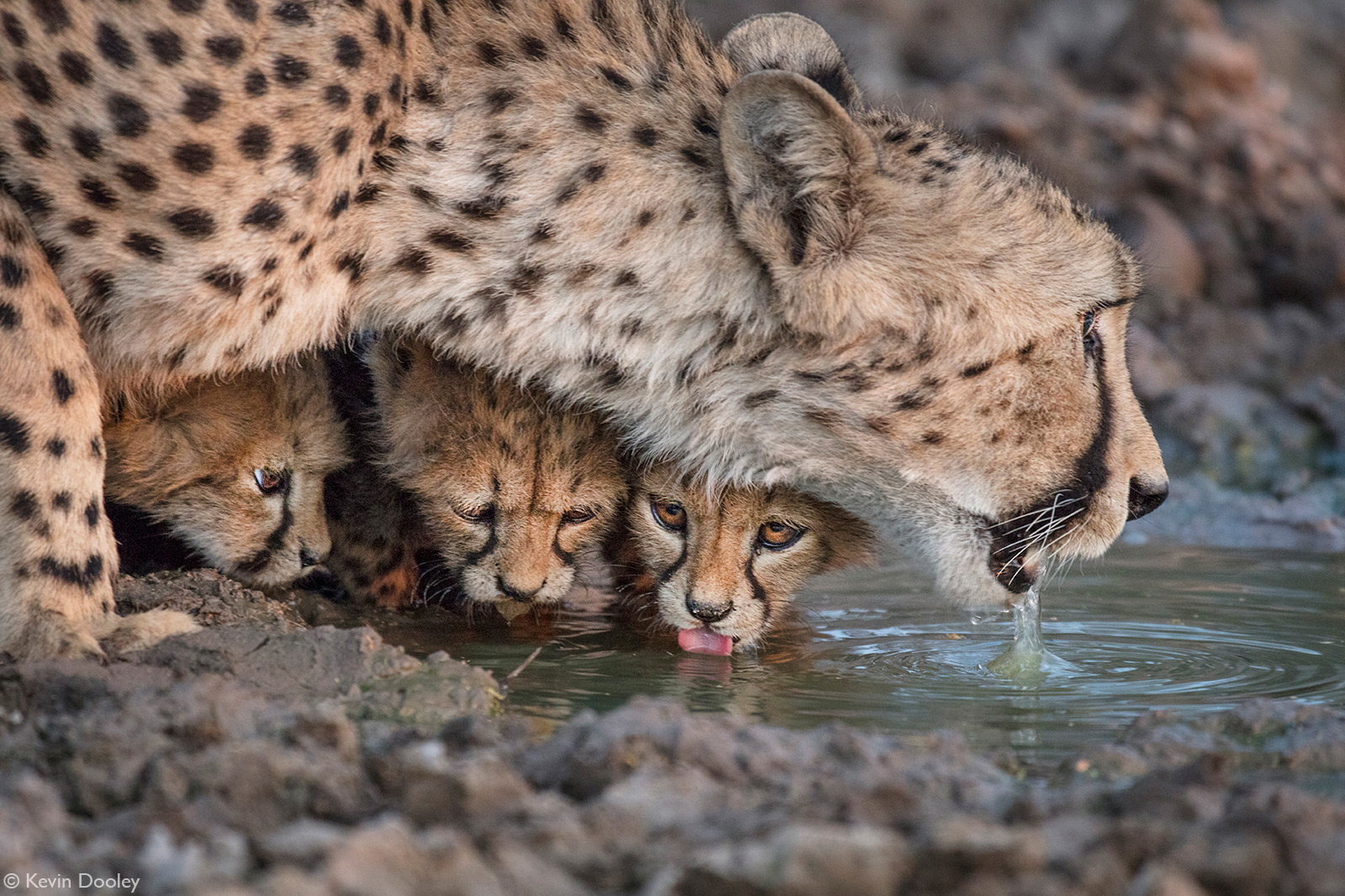
Maintaining complete silence, we sat in the hope that the cheetah and cubs would come to the water. I set my camera at the highest ISO that I was comfortable with and considering the dim light I opted for a slower shutter speed than I usually use. I knew that even at a 400th of a second, it would be a challenge to hold a 700mm lens still enough for a sharp image. While I worked the settings the mother cheetah peeked through thick bushes, before slowly making her way to the water, stopping every few steps to scan the area for danger. Much to our joy her little cubs followed her, and, after what seemed like an eternity, they reached the water. She stood tall, scanning the area once again as the cubs began to drink, and then she leaned over to protect them and to drink. That was my opportunity. Within a few minutes, they disappeared back into the thick bushes, and the moment was over. I love this image because it is a perfect example of how effort and patience come together for the perfect shot.
Judges’ comment
Cuteness aside, this is a beautiful portrayal of a watchful mom and her cautious cubs so well-framed beneath her protective body as they drink.
About the photographer
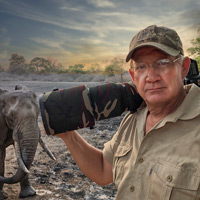 Kevin Dooley was born in a small mountain town in the USA where photography has been his chosen profession for almost 40 years. His passion for wildlife photography and wild places has led to many adventures, especially in Africa. He thrives on sharing Africa with others – teaching them about wildlife, trees and the history of wild Africa. Stories of adventures shared around a campfire with other travellers and photographers hold a special place in his heart. Visit his Instagram page.
Kevin Dooley was born in a small mountain town in the USA where photography has been his chosen profession for almost 40 years. His passion for wildlife photography and wild places has led to many adventures, especially in Africa. He thrives on sharing Africa with others – teaching them about wildlife, trees and the history of wild Africa. Stories of adventures shared around a campfire with other travellers and photographers hold a special place in his heart. Visit his Instagram page.
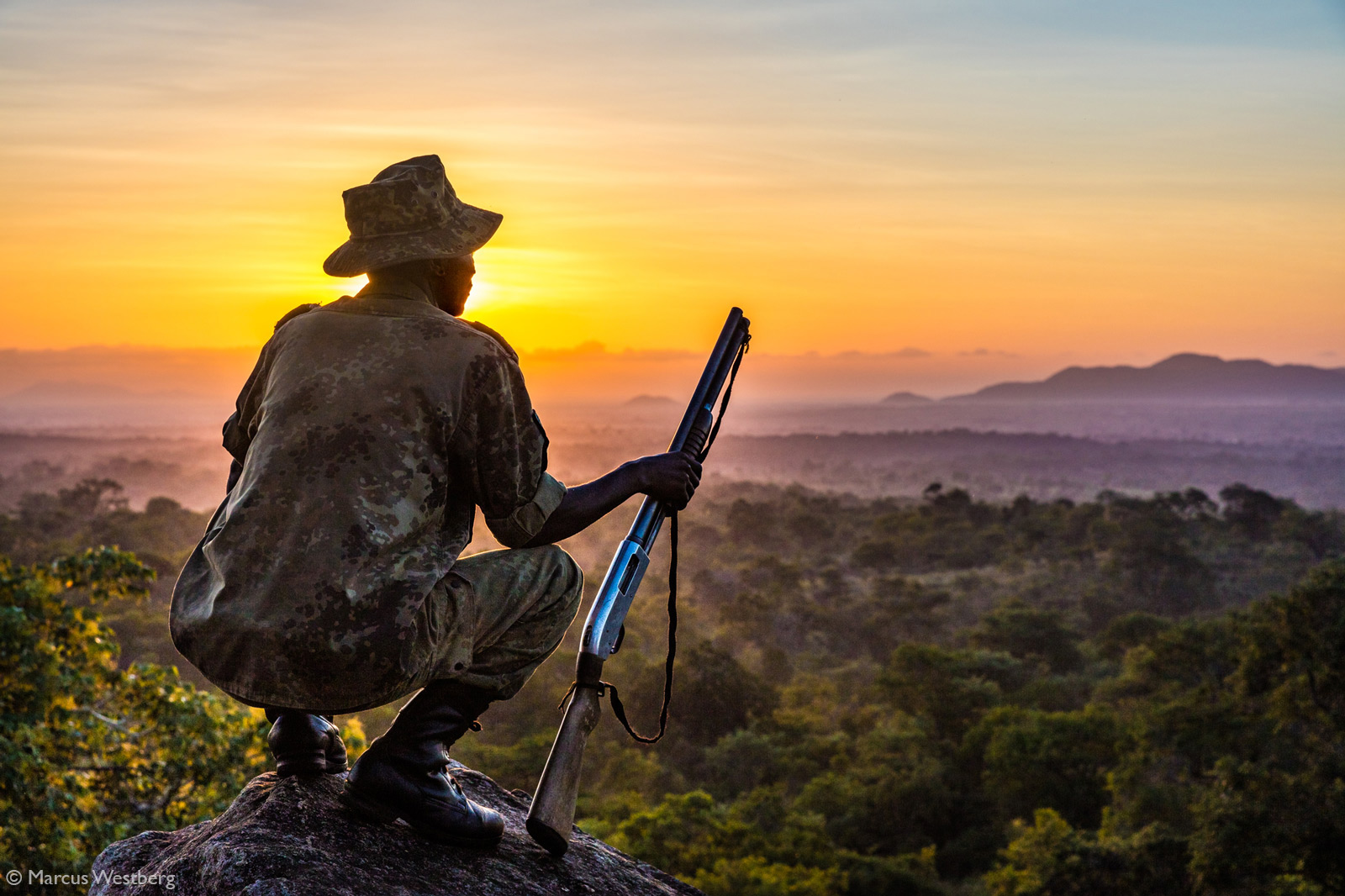
A ranger looks over Thuma Forest Reserve in Malawi. Managed by Wildlife Action Group Malawi, this reserve is an important haven for elephants that runs on a tiny budget – with a small, dedicated team of rangers and other staff. Much of the work consists of managing community relations; made easier because almost all the staff come from villages at the edge of the reserve. Thuma’s elephants (and other wildlife populations) have bounced back remarkably in the last decade.
Judges’ comment
Africa’s true heroes – the protectors of our wild areas – are seldom given the praise and profile that they deserve. This image captures a beautiful sundowner vista and a man who helps keep it safe from the evil ones.
About the photographer
 Marcus Westberg is an award-winning Swedish photographer and writer who focuses primarily on solution-oriented coverage of conservation topics in sub-Saharan Africa. He is a photographer for African Parks, and his work is frequently found in publications such as the New York Times, bioGraphic, Vagabond, Wanderlust and Africa Geographic. Visit his Instagram page.
Marcus Westberg is an award-winning Swedish photographer and writer who focuses primarily on solution-oriented coverage of conservation topics in sub-Saharan Africa. He is a photographer for African Parks, and his work is frequently found in publications such as the New York Times, bioGraphic, Vagabond, Wanderlust and Africa Geographic. Visit his Instagram page.
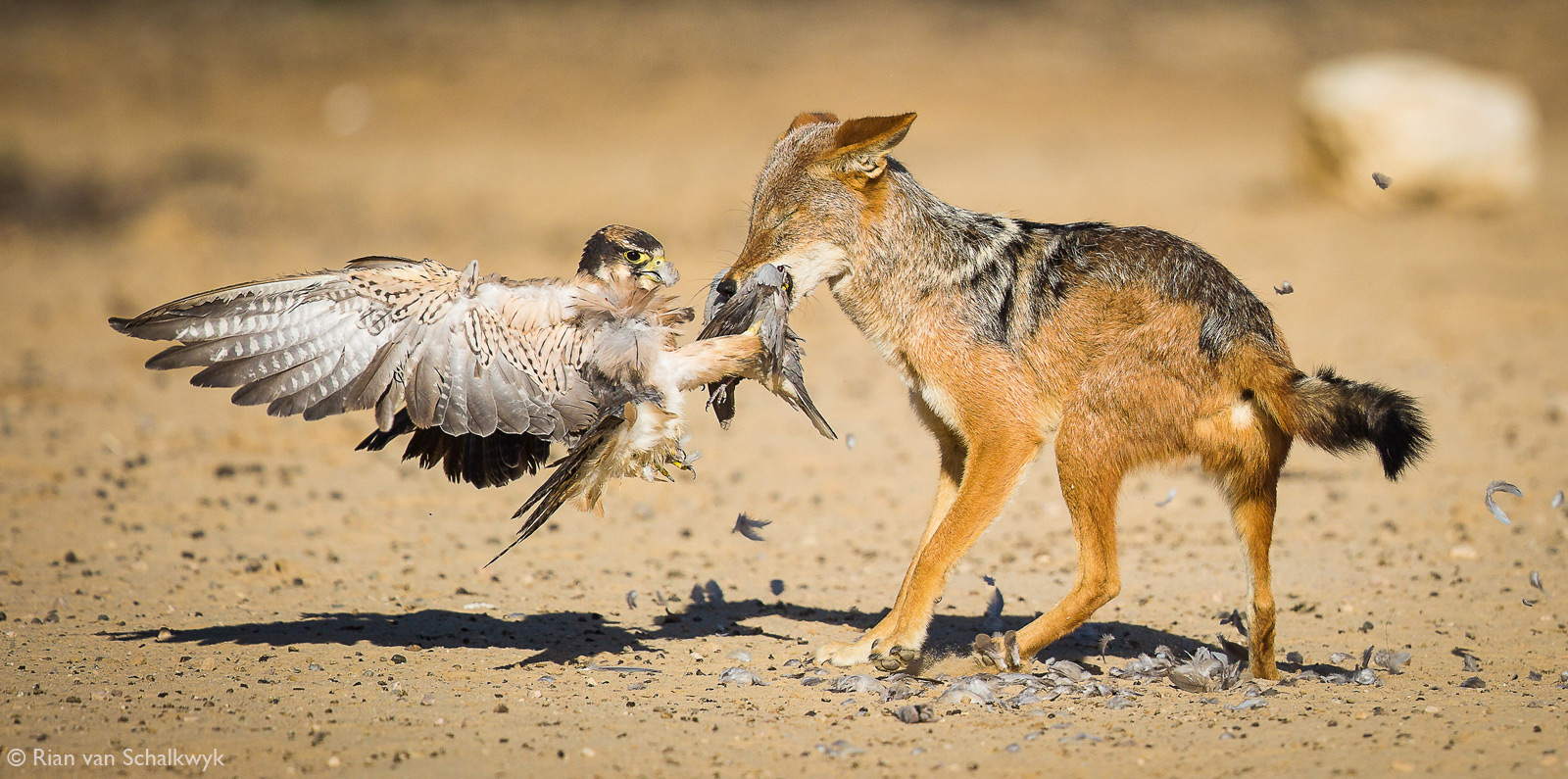
It was early morning at Cubitje Quap waterhole in the Kgalagadi Transfrontier Park, South Africa. It was the dry season, and the doves and sandgrouses came down in their hundreds to drink water.
There was a black crow parading around the waters’ edge, which grabbed a dove by its tail feathers and started to pluck the feathers. A watching lanner falcon swooped down, stole the dove from the crow and continued the plucking of feathers. Then a lurking blacked-backed jackal grabbed the dove from the falcon, and in the process caught hold of the falcon’s talons. What followed is what I refer to as ‘the waltz of death’. The falcon was swung around like a ragdoll. Eventually, the falcon freed itself from this death grip and flew to a nearby tree, seemingly unharmed, while the jackal devoured the dove.
Judges’ comment
The grim determination by these unlikely adversaries makes for an arresting image, with the dove feathers strewn about adding to the drama. One can’t help wondering what happened before and after this split-second capture – and that makes this a great image.
About the photographer
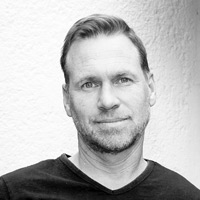 Rian van Schalkwyk is a medical doctor who lives in Windhoek, Namibia. He has a passion for nature and wildlife photography and tries to get into the bushveld at every available opportunity. He recently returned from a 9-month life-changing safari with his daughter – visiting 27 African national parks and reserves. Visit his Instagram page.
Rian van Schalkwyk is a medical doctor who lives in Windhoek, Namibia. He has a passion for nature and wildlife photography and tries to get into the bushveld at every available opportunity. He recently returned from a 9-month life-changing safari with his daughter – visiting 27 African national parks and reserves. Visit his Instagram page.

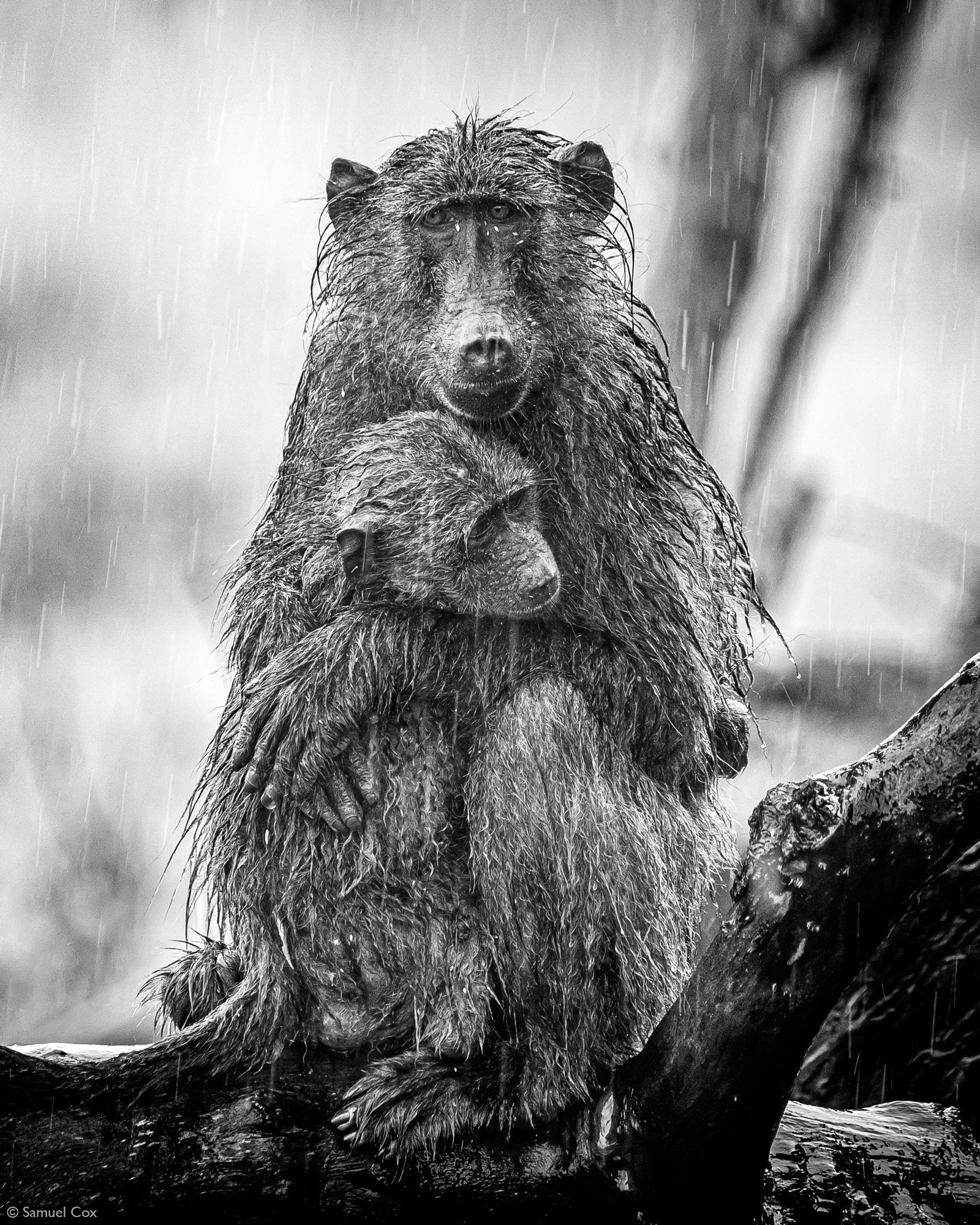
During a photographic trip to the Kruger National Park, the summer rains opened up, and my guests were treated to a new experience. Safe from the rain, we were able to take advantage of the downpour, and one of the focuses I had set was on playing with shutter speeds to get different effects from the falling raindrops. We were lucky enough to sit with a troop of Chacma Baboons as the rain intensified. While the majority were playing and causing havoc, I couldn’t help but be drawn to one mother holding her baby tightly, as if trying to offer comfort and security. I used a slow shutter speed of 1/160, to extend the raindrops into a more menacing needle-like form. The look of utter sadness on the two faces meant there was going to be an emotional connection for anyone who looked at this photograph. Taking out all colour also eradicated any hint of vibrancy and reinforced the glum, cold and dismal feelings my two subjects seemed to be experiencing. It’s an image that, I hope, emotionally resonates with anyone – especially those who have been caught out in the rain.
Judges’ comment
Baboons, like humans, will jump for joy when the first rains arrive. But, once the novelty has worn off, they too will huddle down miserably to wait it out. This image captures that moment perfectly.
About the photographer
 Based in the Greater Kruger of South Africa and working as photography manager for African Impact, Sam looks to introduce and showcase to other like-minded photographers the beauty that had him fall in love with Africa over twenty years ago. With this comes the added responsibility of instilling a thoughtful, ethical and conservation-based approach to how we work with the natural world. Sam’s aim is to teach photographers the importance and impact via education their work can have on the conservation of our natural biosphere. Visit his Instagram page.
Based in the Greater Kruger of South Africa and working as photography manager for African Impact, Sam looks to introduce and showcase to other like-minded photographers the beauty that had him fall in love with Africa over twenty years ago. With this comes the added responsibility of instilling a thoughtful, ethical and conservation-based approach to how we work with the natural world. Sam’s aim is to teach photographers the importance and impact via education their work can have on the conservation of our natural biosphere. Visit his Instagram page.
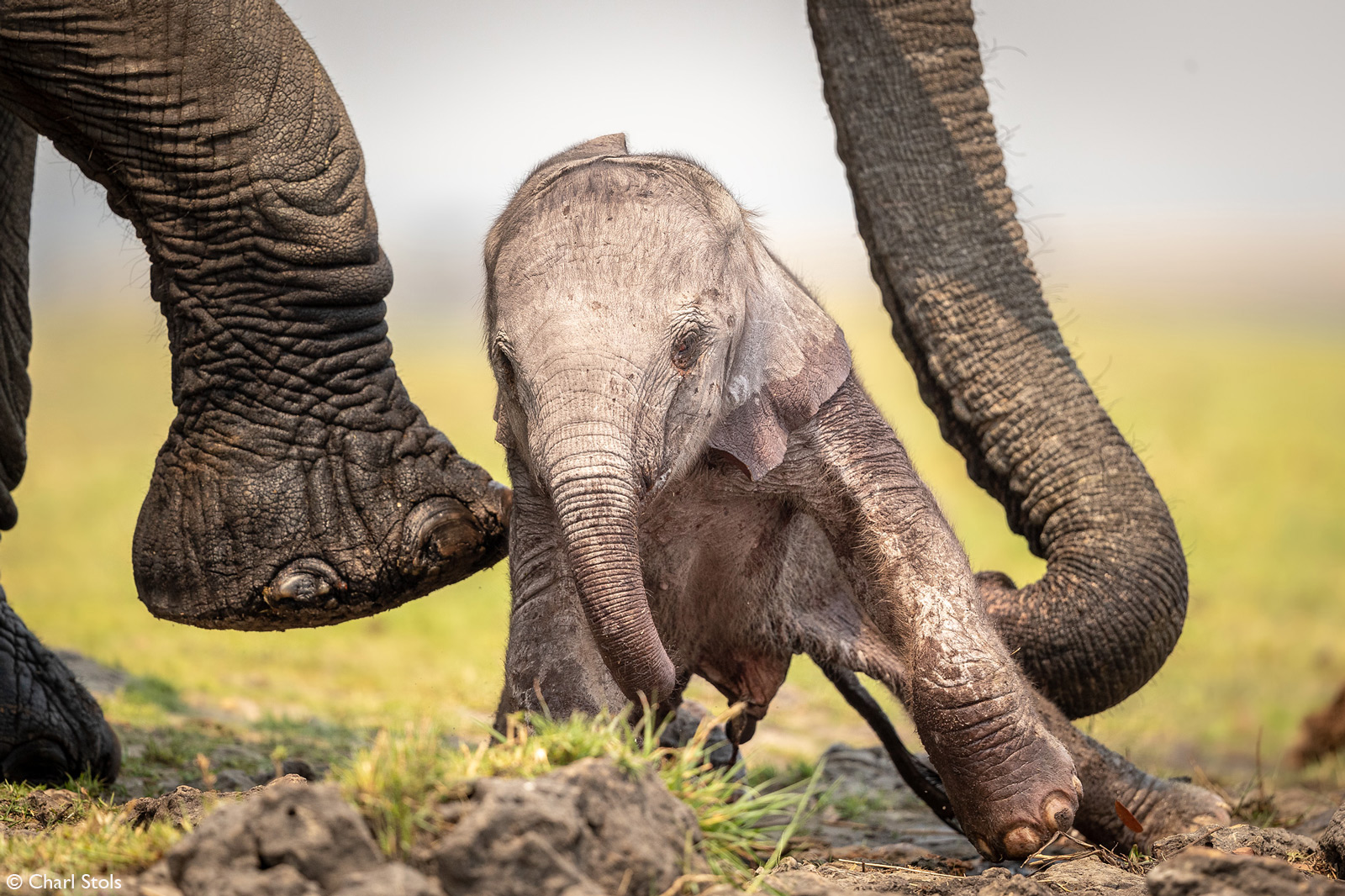
This image of a new-born elephant baby was taken on the Chobe River, Botswana. The calf was still wobbly on its feet and fell a few times, so the mother gently helped it back up by guiding it with her trunk. It was the smallest elephant I had ever seen. Astonishingly it even managed to cross the Chobe River, protected on all sides by the herd.
Judges’ comment
This tender moment tugs at the heartstrings, and the helping ‘hand’ of mom’s massive trunk and foot completes this outstandingly precious capture.
About the photographer
 Charl Stols was born and raised in South Africa, where he was fortunate to visit several national parks. He began his journey in photography in 2003 while working on a cruise vessel as a resident photographer in 2003. During that time he also met his wife Sabine, who shares his passion for photography.
Charl Stols was born and raised in South Africa, where he was fortunate to visit several national parks. He began his journey in photography in 2003 while working on a cruise vessel as a resident photographer in 2003. During that time he also met his wife Sabine, who shares his passion for photography.
Charl and Sabine were offered their dream jobs – as photographic hosts with a photo safari company – where they now work full time. They guide clients on The Chobe River and other iconic photo destinations such as the Okavango Delta, Kalahari and Maasai Mara. Visit his Instagram page.
To comment on this story: Login (or sign up) to our app here - it's a troll-free safe place 🙂.![]()
HOW TO GET THE MOST OUT OF AFRICA GEOGRAPHIC:
- Travel with us. Travel in Africa is about knowing when and where to go, and with whom. A few weeks too early / late and a few kilometres off course and you could miss the greatest show on Earth. And wouldn’t that be a pity? Browse our ready-made packages or answer a few questions to start planning your dream safari.
- Subscribe to our FREE newsletter / download our FREE app to enjoy the following benefits.
- Plan your safaris in remote parks protected by African Parks via our sister company https://ukuri.travel/ - safari camps for responsible travellers




